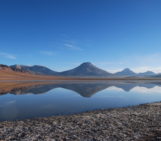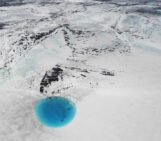Mud volcanoes, unlike many others, do not extrude lava. Instead, they release glutinous bubbling brown slurry of mineral-rich water and sediment. They range in size from several kilometres across, to less than a metre – the little ones are known as mud pots, reflecting their diminutive nature. The world’s largest, though, is Lusi: a mud volcano in East Java that released an astonishing 180,000 cubic metres of fluid each day during the peak of its 2006 eruption. It’s likely to continue erupting for another 26 years!
Much of the gas that bubbles up through these muddy pools is methane, though the exact mix of gasses varies from site to site and is tied to other geological activity in the region, with those close to igneous volcanoes often releasing less methane than those associated with clathrate deposits. Small bubbles of gas can coalesce to form a much larger one, which, on reaching the surface, bursts and sends flecks of clayey fluid asunder, just as they do here:

The sediment-rich spatter from a bubbling mud volcano. (Credit: Tobias Heckmann via imaggeo.egu.eu)
By Sara Mynott, EGU Communications Officer
Imaggeo is the EGU’s open access geosciences image repository. Photos uploaded to Imaggeo can be used by scientists, the press and the public provided the original author is credited. Photographers also retain full rights of use, as Imaggeo images are licensed and distributed by the EGU under a Creative Commons licence. You can submit your photos here.




Pingback: SINOPSIS LUSI DI FORUM EGU 2017-2016 | Hardiprasetyolusi's Blog
Pingback: GeoLog | Imaggeo on Mondays: Lusi from the sky with drones
JPX
Cubic meters, not cubic kilometers.
Bárbara Ferreira
Thanks for spotting the typo. We’ve updated the post now!